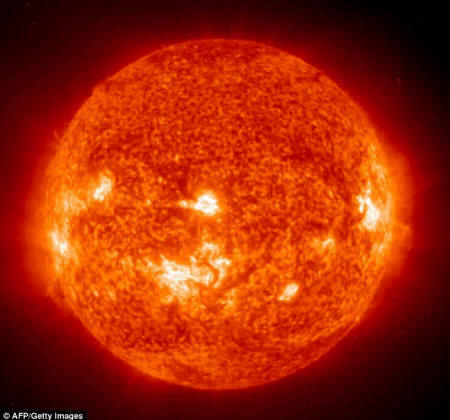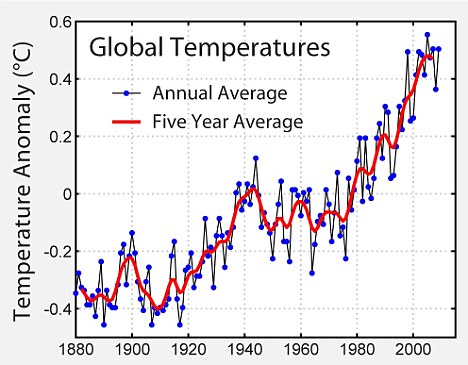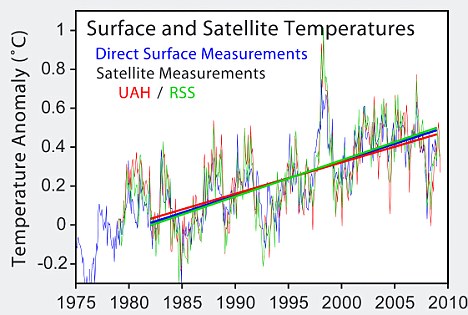|

by Daily Mail Reporter
October 07, 2010
from
DailyMail Website
A puzzling discovery has raised a question mark over the Sun's
impact on climate change and could provide ammunition for skeptics,
it was revealed today.
Until now it has been assumed that less activity from the Sun
equates to less warming of the Earth. But the new research, which
focuses on a three-year snapshot of time between 2004 and 2007,
suggests the opposite may be true.
As
solar activity waned at the end of one of the Sun's 11-year
cycles, the new data show the amount of energy reaching the Earth at
visible wavelengths rose rather than fell.

Several giant sunspots crossing the face of the Sun.
The amount of
solar activity may have negligible effects on the Earth's climate
Scientists believe it may also be
possible that during the next up-turn of the cycle, when sun
activity increases, there might be a cooling effect at the Earth's
surface.
A further twist arises from the fact that over the past century,
overall solar activity has been increasing.
If the new findings apply to long as well as short time periods,
this could translate into a small degree of cooling rather than the
slight warming effect shown in existing climate models. It would
effectively turn received wisdom on its head.
Skeptics are likely to say the results further undermine the
reliability of climate change science, especially with regard to
solar effects.
Professor Joanna Haigh, from Imperial College London, who led the
study, said:
'These results are challenging what
we thought we knew about
the Sun's effect on our climate.
However, they only show us a snapshot of the Sun's activity and
its behavior over the three years of our study could be an
anomaly.
'We cannot jump to any conclusions based on what we have found
during this comparatively short period and we need to carry out
further studies to explore the sun's activity and the patterns
that we have uncovered on longer timescales.

The rising sun
lights up the sky as low-lying clouds sit along the horizon in
Wyoming.
Researchers have
warned against jumping to any conclusions
based on what the
have found during this 'comparatively short period'
'However, if further studies find
the same pattern over a longer period of time, this could
suggest that we may have overestimated the sun's role in warming
the planet, rather than underestimating it.'
Speaking at a news briefing in London,
she denied that it would fuel skepticism about climate change
research.
'I think it doesn't give comfort to
the climate skeptics at all,' she said.
'It may suggest that we don't know that much about the Sun. It
casts no aspersions at all upon the climate models.'
The research, published in the journal
Nature, is based on data from a satellite called
SORCE (Solar
Radiation and Climate Experiment) that has been measuring the Sun's
energy output at X-ray, ultraviolet, visible, and near-infrared
wavelengths.
Prof Haigh's team found that, above an altitude of 28 miles,
concentrations of ozone in the atmosphere increased as total solar
output decreased.

How global temperatures have risen steadily since records began in
1880

How Surface and satellite temperatures have varied over the past 35
years
The ozone rise accompanied a steep fall
in levels of ultraviolet radiation.
Closer to the ground, an increase in visible radiation caused
heating of the lower atmosphere.
'At face value, the data seem
incredibly important,' Michael Lockwood, a space physicist at
the University of Reading, told Nature.com.
'If solar activity is out of phase with solar radiative forcing,
it could change our understanding of how processes in the
troposphere and stratosphere act to modulate Earth's climate.'
'The findings could prove very significant when it comes to
understanding, and quantifying, natural climate fluctuations,'
he added.
'But no matter how you look at it, the Sun's influence on
current climate change is at best a small natural add-on to
man-made greenhouse warming.'
'All the evidence is that the vast majority of warming is
anthropogenic. It might be that the solar part isn't quite
working the way we thought it would, but it is certainly not a
seismic rupture of the science.'
|




